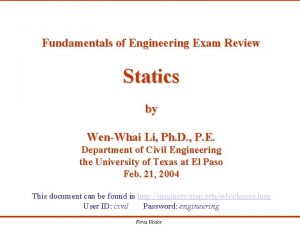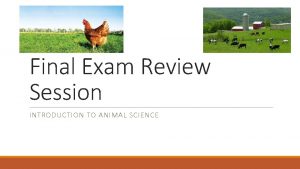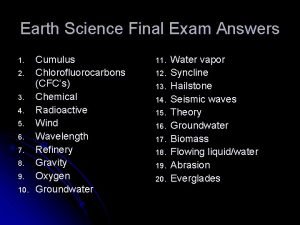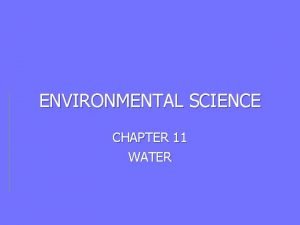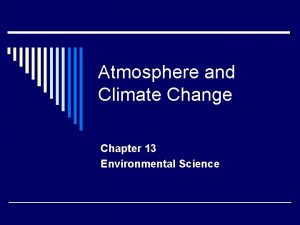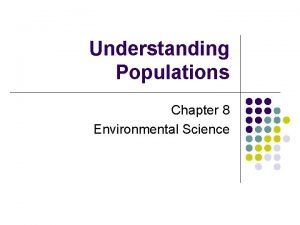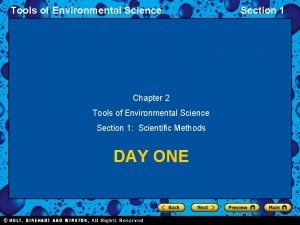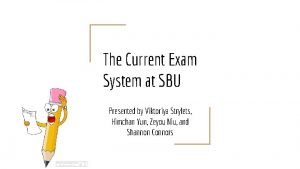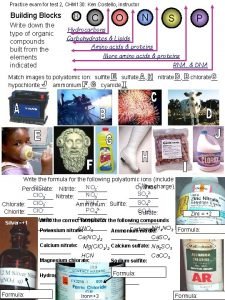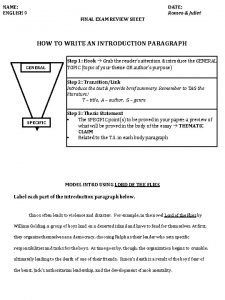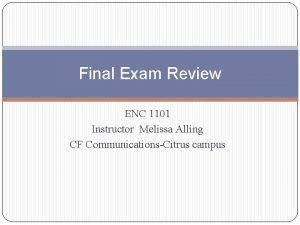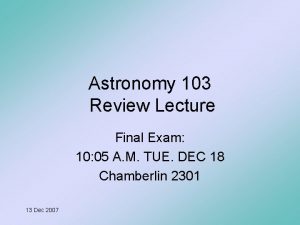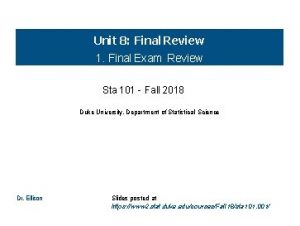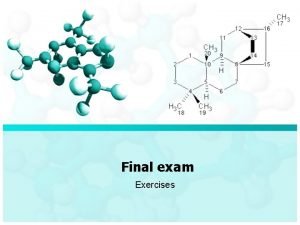Environmental Science Final Exam Review Environmental Science the






























































- Slides: 62

Environmental Science Final Exam Review

Environmental Science • the study of how humans interact with their environments.



Intro to Ecosystems Definitions • Ecology - the scientific study of interactions among organisms and their environment, such as the interactions organisms have with each other and with their abiotic environment. • Ecosystem - a biological community of interacting organisms and their physical environment. • Environment - the biotic and abiotic surrounding of an organism or population, and includes the factors that have an influence in their survival, development and evolution.

Intro to Environmental Science • Biotic - a living or once living component of a community • organisms, such as plants and animals. • Abiotic - are those non-living chemical and physical parts of the environment that affect ecosystems. • Air, water, soil…

Intro to Ecosystems



An organism’s biomass is made out of its total dry mass. The biomass in a given step within a food chain will always be smaller than the one from the previous step.



Ecological succession is the process of change in the species structure of an ecological community over time. The time scale can be decades (for example, after a wildfire), or even millions of years after a mass extinction. Primary Succession begins with bare rock (no soil); lichens, mosses and ferns Secondary Succession begins with soil; weeds and wildflowers are first plants.



Biomes



Energy • Nuclear Fission • (split atom) • Nuclear Power Plant • Nuclear Fusion • (bombard atoms) • On the Sun

The word fission means "a splitting or breaking up into parts“ Nuclear fission releases heat energy by splitting atoms. The surprising discovery that it was possible to make a nucleus divide was based on Albert Einstein’s prediction that mass could be changed into energy. In 1939, scientist began experiments, and one year later Enrico Fermi built the first nuclear reactor. Inside the sun, fusion reactions take place at very high temperatures and enormous gravitational pressures

Radioactive waste is usually a by-product of nuclear power. Radioactive waste is hazardous to all forms of life and the environment, and is regulated by government agencies in order to protect human health and the environment. The radioactivity of all radioactive waste weakens with time. (Uranium)









Biodegradable vs. Nonbiodegradable

Composting Benefits



Percentage of Waste Produced by Households and Businesses



Symbiosis: Mutualism, Commensalism or Parasitism?






Geology – Rock Cycle

Most Abundant Rocks….

Forestry Primary Succession: No Soil (lichens, moss, ferns…) Secondary Succession: Soil (grasses, annuals, perenials…)

• Physical Parameters – Texture (Sand, Silt, Clay) – Organic vs. Inorganic – Percolation Rate 50% Pore Space, 45% Mineral, 5% Organic matter. Soil Ecology R Horizon (rock)

Soil Ecology • Chemical Factors – p. H – Nitrogen – Phosphorous – Potassium

• Major Nutrients: • (N) Nitrogen – green leaves, quality & protein of fruit • (P) Phosphorus - (phosphates) – strong roots, increases seed yield and fruit development • (K) Potassium - (potash) – color of flowers, quality of fruit, vigorous root growth

p. H of Pa Soils • Eastern Pa soil p. H 4 -6 • Agricultural soil is best if between p. H 6 – 8 (except for certain acid loving plants) • Appalachian mountain valleys contain limestone which balances out acidic soil = good growing soil.


Climate

*Graph shows exponential growth


Human Histogram Population Growth

Forestry

Tree I. D. Compound Leaflet Arrangements

Tree I. D. Leaf Margins

Leaf Pigments • • Chlorophyll ------ Green Xanthophylls ----- Yellow Carotenes ------ Orange Anthocyanin ------ Red


Pennsylvania State Tree Eastern Hemlock (Tsuga canadensis), Pennsylvania State Tree The eastern hemlock (Tsunga canadensis) was designated official state tree of Pennsylvania in 1931. Eastern hemlock trees were used by early settlers to build log cabins and as a source of tannic acid (for tanning leather). The eastern hemlock (also called Canada hemlock or hemlock spruce) was pronounced the most picturesque and beautiful of the world's evergreens by A. J. Downing, the father of landscape gardening in America. The eastern hemlock is a prevalent tree in Pennsylvania forests. A slow-growing, longlived tree which can take 250 - 300 years to reach maturity and may live for 800 years or more.

Physiographic Provinces of Pennsylvania http: //www. dcnr. state. pa. us/topogeo/field/map 13/index. htm Piedmont Province

Climate: Appalachian Mtns. / Atlantic Ocean
 Environmental science final
Environmental science final Writ of certiorari ap gov example
Writ of certiorari ap gov example Physical science final exam review
Physical science final exam review Earth science final exam review
Earth science final exam review World history spring final exam review answers
World history spring final exam review answers Spanish 1 semester 1 final exam answer key
Spanish 1 semester 1 final exam answer key Pltw human body systems final exam
Pltw human body systems final exam Truss practice problems poe
Truss practice problems poe Ied final exam review
Ied final exam review World history regular semester 1 review
World history regular semester 1 review Principles of business final exam answer key
Principles of business final exam answer key Spanish 2 review packet
Spanish 2 review packet World history final exam study guide
World history final exam study guide Us history final exam semester 2
Us history final exam semester 2 English 11 first semester exam
English 11 first semester exam Physics fall final exam review
Physics fall final exam review Mat1033c
Mat1033c Fe exam statics review
Fe exam statics review Zoology final exam review
Zoology final exam review Algebra 2 semester 2 final exam
Algebra 2 semester 2 final exam Hft 2401
Hft 2401 Personal finance final exam review
Personal finance final exam review Spanish 2 review
Spanish 2 review Psyc 1504 final exam
Psyc 1504 final exam Animal science final exam
Animal science final exam Earth science semester 2 final exam answers
Earth science semester 2 final exam answers Ap environmental science exam pass rate
Ap environmental science exam pass rate Chapter 11 review environmental science
Chapter 11 review environmental science Environmental science chapter 13
Environmental science chapter 13 Chapter 8 environmental science
Chapter 8 environmental science Chapter 2 environmental science
Chapter 2 environmental science Three levels of biodiversity
Three levels of biodiversity Why environmental science is an interdisciplinary science
Why environmental science is an interdisciplinary science World geography spring final review
World geography spring final review Web design final exam
Web design final exam U.s. history final exam semester 2
U.s. history final exam semester 2 Sbu finals schedule
Sbu finals schedule Latin 2 final exam answers
Latin 2 final exam answers Latin study guide
Latin study guide Street law final exam
Street law final exam Pointing
Pointing Realidades 2 final exam
Realidades 2 final exam Chemistry 151 final exam
Chemistry 151 final exam Chm 130 chapter 12 practice problems answer key
Chm 130 chapter 12 practice problems answer key Romeo and juliet final exam
Romeo and juliet final exam 42 final exam
42 final exam Aice english general paper
Aice english general paper Question paper of human resource management
Question paper of human resource management Hospitality and tourism final exam
Hospitality and tourism final exam Hbs final exam
Hbs final exam Enc 1101 final exam
Enc 1101 final exam Safe schools training ferpa answers
Safe schools training ferpa answers Creative nonfiction final exam
Creative nonfiction final exam Abc final exam practice test
Abc final exam practice test World literature in english
World literature in english Cs 1104 computer systems
Cs 1104 computer systems Cs 1101 programming fundamentals final exam
Cs 1101 programming fundamentals final exam Civics and economics final exam
Civics and economics final exam Gold coast final exam 1 answers
Gold coast final exam 1 answers Astronomy 103 final exam
Astronomy 103 final exam American literature final exam
American literature final exam Definition of a circle in geometry
Definition of a circle in geometry Web design final exam
Web design final exam

















